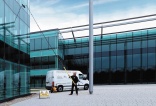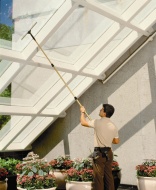Home › magazine › latest news › Window cleaning safety first
Window cleaning - safety first
10th of August 2015Window cleaning has long been associated with working from height along with all the risks that this involves. But since the advent of water-fed poles, how safe is window cleaning today? And what products are there on the market that can further improve window cleaners’ safety? Ann Laffeaty finds out.
Concern for personal safety is becoming increasingly prevalent in today’s society. Over the past 30 years we have seen a growing trend for items such as infant car seats, personal protective clothing, bicycle helmets and rubberised surfaces for children’s playgrounds.
Safety in cleaning has also come under the spotlight and stricter regulations have come into effect to reduce the number of accidents and injuries in the industry.
Window cleaning is one of the riskiest cleaning tasks of all. It is frequently cited in online polls and on insurance websites as being one of the most dangerous jobs in the world alongside occupations such as logging, mining, fire-fighting and road-working.
The advent of water-fed poles has helped to reduce the number of operatives working from ladders which comes with an obvious risk of falling. But recent events would suggest that the dangers of window cleaning are still very real.
In November 2014, two window cleaners in New York had to be rescued after the cables securing their work basket malfunctioned. This left them dangling precariously at a near 75-degree angle on a platform near the 69th floor of One World Trade Centre. In a dramatic rescue hundreds of feet above the ground, fire department workers had to saw through the windows and haul the two to safety.
In March 2014 a stranded window cleaner in Toronto had to be rescued by firefighters after her hair became caught in a descending rope line. Earlier the same year a window cleaner in the UK sustained serious injuries after falling from a ladder through a conservatory roof.
And in a horrific accident in December 2013, a window cleaner plummeted 47 storeys from the roof of a Manhattan skyscraper. Miraculously the operative sustained only minor injuries after having clung to the scaffolding platform as it fell.
Scores of window cleaning accidents and even deaths are reported every year, usually as a result of falling from height. The EU Work at Height Regulations 2005 alleviated the problem to some extent by stipulating that if a window cleaning task could reasonably be carried out from the ground, that is how it should be done. But this of course is impractical when cleaning skyscrapers and other high-rise buildings.
And in any case, water-fed poles come with their own safety issues. Operators can incur injuries to their arms, wrists or backs when handling unwieldy poles for instance. In some cases, pole sections may fall to the ground and injure passers-by. And cleaning with water-fed poles can lead to a great deal of water spillage which could cause slips and trips on the part of the window cleaner or members of the public, particularly in icy conditions.
Modular systems
Unger is one of those companies to have embraced the challenge of increasing the safety of water-fed pole systems according to product marketing coordinator Axel Droste. “For many years window cleaners have had the choice of two types of pole system: telescopic or modular,” he said.
“However, telescopic poles can tend to flex as they are extended and this brings a subsequent loss of control. They also have some weight issues; for example, a six-section telescopic pole will always have six sections since none of these cannot be removed – so even if you only need to use four sections to clean to the height required, you will still be carrying the weight of six.
“Modular systems, although better at extending without losing rigidity, simply become too heavy when they are extended. And these extensions also add width to the poles which makes them more difficult to handle.”
His says this situation has presented manufacturers with a challenge. “How do you create a water-fed pole system that will clean at heights of up to 65 feet, but that will also be both lightweight and easy to control?” said Droste. “Along with engineering and design techniques it is crucial to use the right materials and combine the best features of telescopic and modular poles. And an increasing number of options are emerging to provide specific solutions.”
Stronger and rigid
According to Droste, water-fed pole materials such as carbon fibre, fibre glass and aluminium have all offered choice and flexibility to the window cleaning sector. “These have helped to create equipment to suit each situation and building type,” he said. “Carbon fibre in particular offers an amazing balance between strength, weight and rigidity. In comparison to steel it is both stronger and more rigid yet weighs considerably less.”
He adds that today’s new lighter poles make the cleaning operative’s job easier, safer and more comfortable while putting less of a strain on their bodies and enabling them to clean more swiftly and efficiently.“The fact that these systems are lighter in weight also means that the operative is less likely to become tired so quickly, which means they can clean a larger surface area than when using a conventional system,” he said.
“However just because the poles are more lightweight it doesn’t mean that they deliver less in terms of rigidity. Even when extensions are added to increase the length and reach of the system, the poles do not bend or become unwieldy. On the contrary rigidity, and therefore control, is maintained which allows every corner and crevice to be cleaned thoroughly”.
Unger offers the nLite modular system which is basically a telescopic pole that can be extended by another telescopic pole, says Droste. The base unit has four sections and an extended length of 6.63 metres while the extension has two sections at a length of 3.41 metres.
“Depending on the material used you can add up to four extensions to reach a height of 20 metres,” he said. “The individual components can be selected and put together to create a system to suit personal requirements. There are six grades of materials in the nLite range to suit various cleaning challenges and budgets.”
He adds that taller buildings need regular, thorough and effective cleaning to ensure that they present a professional face to customers. “But how do you deliver the high standards that are expected while also making the lives of operatives safer and easier?” he said. “Professional
window cleaners have adapted to these challenges by embracing new methods and equipment.”
According to Moerman director Marc Roels the main health and safety risks for window cleaners include falls from ladders, wrist injuries and falling poles. “Working at Height legislation is moving the window cleaning industry into new directions and spearheading innovative developments,” he said. “It is important that we continually work towards safer practices since there is always
room to improve.”
Moerman’s latest innovation in terms of safe window cleaning is the Liquidator. This system is said to allow operatives to clean right up to the edges of the window frame, leaving little or no water residue. This is claimed to significantly reduce the amount of time spent on prepping with a cloth.
No stretching
“With our Liquidator there is no real need for detailing,” said Roels. “This means operatives do not need to stretch out with a detailing cloth which can heighten the risks of falling. The Liquidator also ‘floats’ over the glass which means that less effort is required during cleaning - and this in turn reduces the tension on operatives’ muscles and wrists.”
He says the future of window cleaning will greatly depend on the type of buildings being built. “Skyscrapers, for example, will always need to be cleaned from height but there will continue to be evolutions that allow the task to be carried out more safely,” said Roels.
Unger’s Droste agrees that the building industry will be key in determining the future of window cleaner safety. “Whether we are talking about the Shard in London, the Commerzbank Tower in Frankfurt or the Torre de Cristal in Madrid, the fashion for high-rise, hi-tech designs featuring plenty of glass and metal does not look like slowing down any time soon,” he said.
“The majority of our most iconic buildings seem to prove the theory that size matters – at least in terms of height. If high-rise buildings continue to be built, window cleaner safety will continue to be a challenge. “










